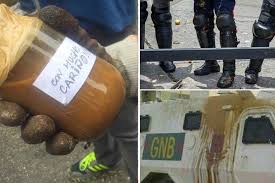Tear Gas vs. “Poop Bombs” in Venezuela
By Nestor Rojas Mavares (dpa)

HAVANA TIMES — Protests against Nicolas Maduro’s government have shaken Venezuela for eight weeks now and have already left at least 60 dead.
The protests began on April 4th, after the opposition majority in the National Assembly (Congress) accused the Supreme Court of Justice of perpetrating a coup d’etat with two rulings that stripped it of its legal powers.
Even though these rulings were partially withdrawn by the Court, the opposition insists on holding the government accountable for the breakdown in constitutional order and thereby is encouraging protests to take place nearly every day.
Demonstrations have increased political tensions, where different groups come together. The following are some of the key points about the protests and their protagonists.
Government Politicians: Pro-government political forces carry out regular displays of support for the Government, with marches through the heart of Caracas, which is the part of the city that has been cut off and banned from opposition marches. Maduro and Chavism’s second-in-command, Diosdado Cabello, have rallied with their followers, who can be identified by their red t-shirts. Leaders highlight the need for peace and order at their rallies, while claiming that opposition protests call for violence.
Political opponents: The opposition is being led by the state governor of Miranda and former presidential candidate, Henrique Capriles, and legislative leaders Julio Borges, Henry Ramos and Freddy Guevara. They can be seen at these marches, dealing with the effects of police tear-gas. Capriles was even injured on Monday (May 29th) during one of these marches. Opposition leaders agree on the need to demand elections, the release of political prisoners, respect for the Legislature and the opening of a humanitarian channel in the face of severe food and medicine shortages.
Security forces: The Government has argued that National Police squads and the Bolivarian National Guard (militarized police) “democratically” deal with these protests. The National Police force has around 15,000 troops, while the Armed Forces have a little over 100,000, if you add up those in the Guard, Army, Marine and Air force.
Protester’s resources: In order to confront security forces, they have been equipped with antigas masks and wooden or metal shields. They respond with weapons such as human excrement bombs (mixed with water) popularly known as “poop bombs”. These are small glass bottles and giant slingshots.
Opposition members carry the Venezuelan flag upside down. They say it represents a S.O.S. message. The Education Minister, Elias Jaua, ordered several private colleges to be penalized for raising the flag upside down, thereby demanding respect for Venezuela’s national symbols. The protestor who confronted the police naked and the old lady who stopped an armored vehicle with her body have become opposition symbols.
Security forces’ resources: Their main weapons are tear gas bombs, rubber bullets and trucks with water cannons, popularly called “whales”. The opposition has reported that they fire pieces of glass or metal with slingshots at them from their frontlines, which over distance and with momentum can become lethal weapons.
Armed civilians: Dubbed the “collectives”, they have been reported by the opposition as armed groups who are tolerated and supported by the Government. In recent days, the Attorney General accused the Police forces of allowing these groups to act freely at protests. The most well-known “collectives” are the “Tupamaros”, “Alexis Vive” and the “Piedrita”, whose leaders have been photographed with real weapons. Capriles accuses these groups of attacking protesters with the security forces’ permission.
Students: University students who are the heirs of the 2007 generation, which contributed to defeating the socialist constitutional reforms that president Hugo Chavez put forward then, have once again mobilized. They are called “millenials” and they crowd together in Altamira Square in the Chacao municipality of the capital, Venezuela’s main opposition base. They take their schoolwork out to the street, where they protect themselves as best they can from the effects of police tear gas. Some have warmed to the idea of responding to the police with “poop bombs”.
Artists: Several artists have joined opposition marches or have made public calls for the violence to end. The most famous being orchestra conductor Gustavo Dudamel, who used to be a close figure to the Government. Former members of the reggaeton band China and Nacho have also joined him. Miguel Ignacio Mendoza and Jesus Miranda, each of them on their own side, have also joined marches against the Government. Another artist who has been present at protests is singer Azier Cazalis, the leader of rock band Caramelos de Cianuro. Abroad, Spanish singer Alejandro Sanz recently said that Venezuela is in intensive therapy and that it needs help.
Athletes: Famous baseball and soccer players have made their thoughts known on social media, calling for an end to government repression and in favor of democratic elections. The coach of the national baseball team which took part in the World Baseball Classic this year, Omar Vizquel, published a message where he asked for the end of the “ruthless” repression against protestors. The “zurdo de oro” and former captain of the national soccer team, Juan Arango, used an emblem on his uniform with the Zulia FC team to ask for peace.
Protests abroad: Government representatives have been exposed to opposition protests abroad. In the most prominent case, the Venezuelan ambassador to Spain, Mario Isea, reported that a cultural center where he was attending an event had been sieged by protestors.





